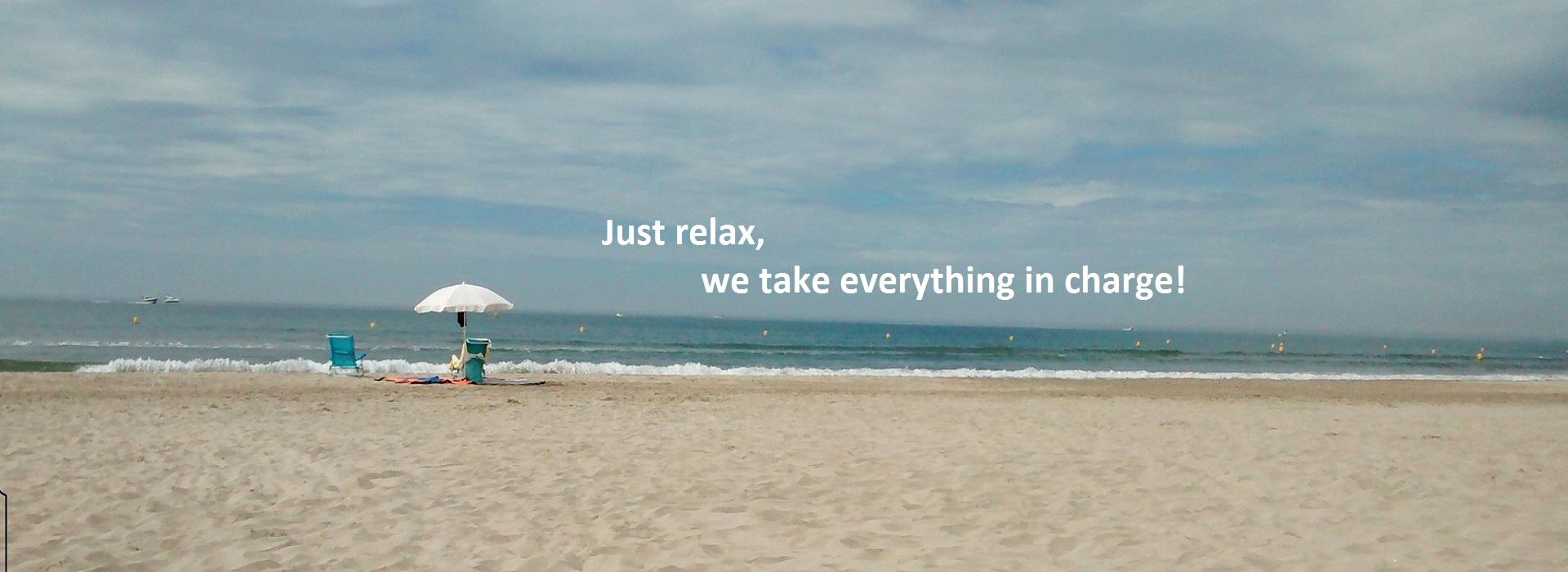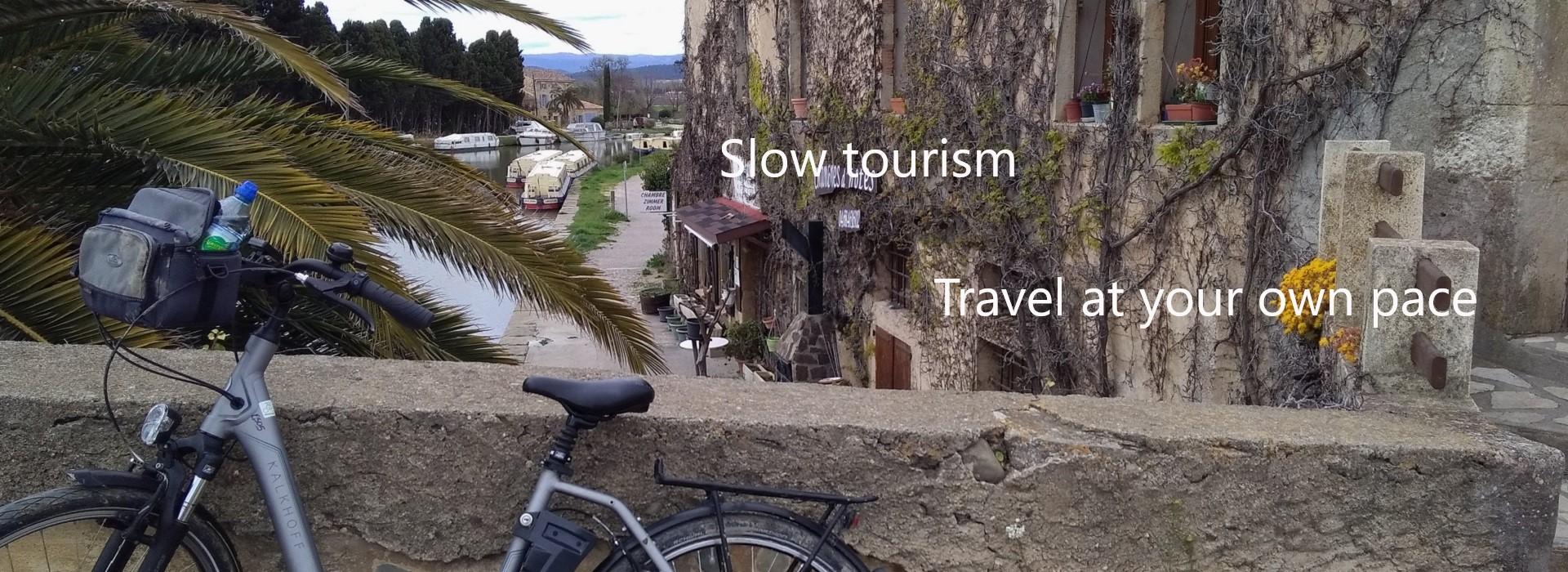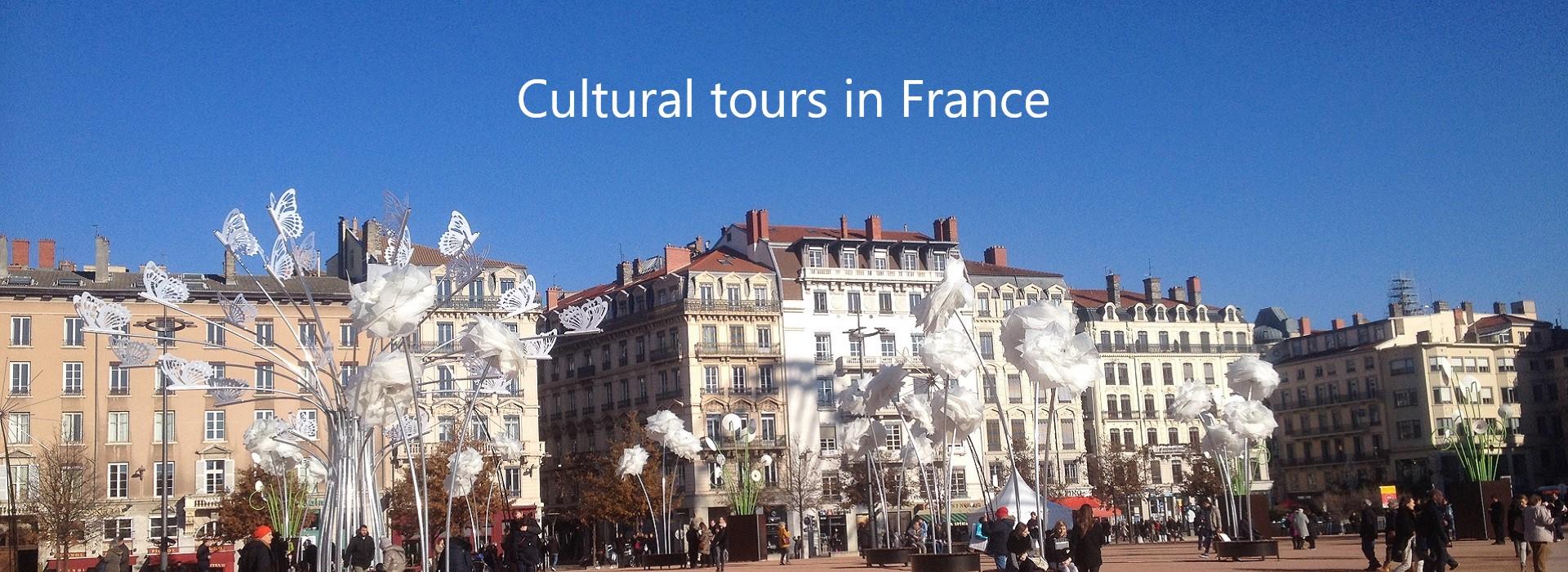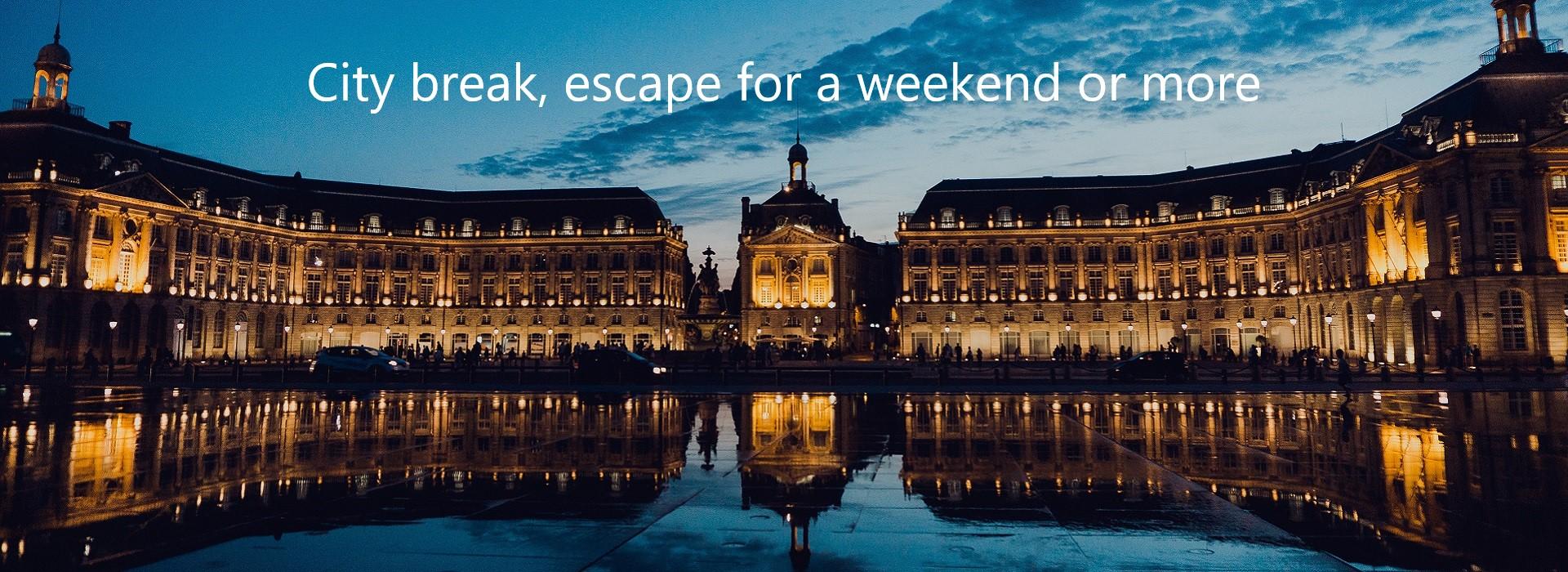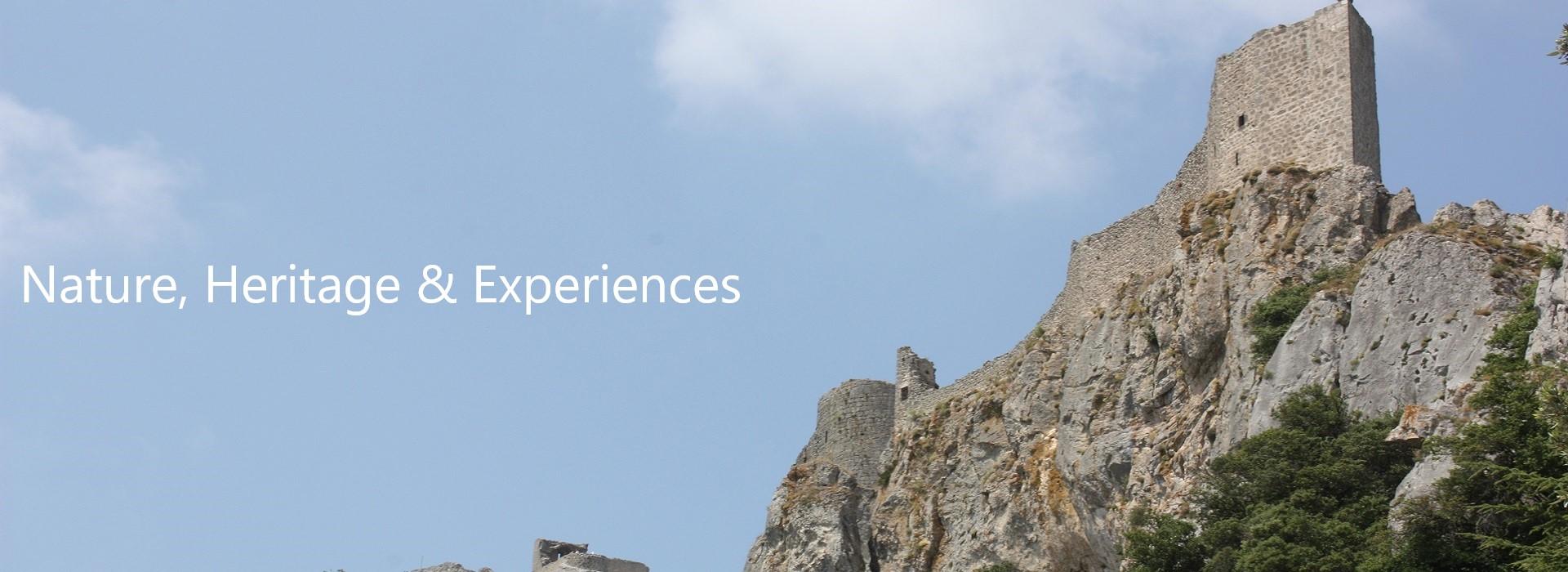Travel to the Corbières region
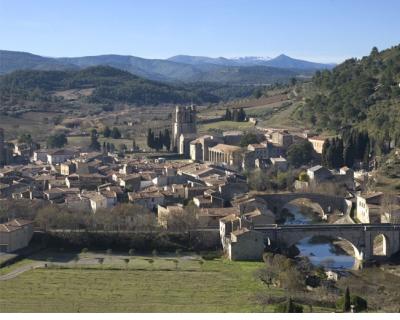
The Massif des Corbières extends on the departements of Aude and Pyrénées-Orientales, in the region of Occitania, former Languedoc Roussillon, in the southwest of France.
It is bounded by the river Aude to the north and west, the Fenouillèdes to the south and the Mediterranean to the east. This proximity to the sea gives the region a mild climate particularly indicated for the cultivation of the vine and the production of honey with scents of rosemary.
The nearest towns are Carcassonne, Narbonne, Axat and Rivesaltes.
The Corbières massif culminates at the Pic de Bugarach which is perched at 1231 m altitude. Three other heights ranging from 1000 to 600 m above sea level draw the relief: Serre de Bec, the Montoulié of Périllou and Mount Tauch. The area is crossed by the river Orbieu which passes through the gorges of the same name, then by a series of valleys dug by the streams and communicating with wild and preserved plains. This is a place to visit when visiting Carcassonne and its surroundings.
Connections with the foreign countries are mainly via the airports of Perpignan, Carcassonne or Toulouse (even Barcelona is only a 2 and half-hour drive), while the train stations served by the TER and TGV lines, ensure the connection with the rest of France.
It should be noted that there is very little public transport across the Corbières massif. The roads are little borrowed and often narrow, but visitors are largely rewarded with breathtaking landscapes that remain magical even after several visits. The little traffic is also the main attraction for cyclists!
9 km long, the Gorges of the Orbieu can be explored on foot by a trail from the village of Montjoi. It is necessary to learn from a guide before any outing because they have a good knowledge of the topology of the place. Those of the Agly house a hermitage built in the cliff and lend themselves to the practice of canyoning. For the unconditional of hiking, the Cathar trail, 250 km long, runs in twelve steps and offers a wide range of possibilities for mountain biking, road bike and horseback riding. Accompanied by a guide who will lead you, you can discover the wonders of nature and the beautiful landscapes of the region.
It presents countless points of interest for lovers of old stones with its high and low parts. The waters of the Canal du Midi, bordered by vines, flow serenely.
This city occupied a strategic position at the time of the Crusades during which the Catharism experienced rapid development. The followers of this religious current deemed heretical by the clergy found the protection of Viscount Trencavel in the 12th century. The armies of Pope Innocent III sacked the city after 15 days of siege in 1209. The reach history of the city will be explained by guides as talented as passionate.
Carcassonne holds also the ramparts of the 52 towers spread over a double enclosure measuring three kilometers long. The Gallo-Roman ramparts built between the 3rd and 4th centuries are distinguished by its brick ropes, while the outer walls dating from the 13th century are complemented by a dry ditch. How could anyone remain impervious to the majesty and beauty of the buildings classified World heritage by UNESCO?
A legendary city that houses a myth that dates back to the 9th century, under the occupation of the Saracens. Charlemagne had established a siege, but Lady Caracas, who ruled over the place, resisted bravely. Famine raged on both sides but she had the idea of releasing a fattened piglet to impress his opponents. Peace was signed to the sound of bells and trumpets, hence the name Carcassonne which literally comes from "Caracas Sonne!".
Want to know more about Carcassonne? read our article!
The ruins of the Saint-Michel Priory of Nahuze, built on the slopes of Alaric Mountain, are not left out, as is the Notre-Dame de Carla chapel. Other essentials are the Sainte-Marie-d'Orbieu Abbey and the Heritage House.
Occupied since the 13th century, the site of the Château Arques is also a mythical landmark in the history of the Cathar country. In 1231, during the crusade against the Cathars, it fell in the hands of Simon IV de Montfort to whom we owe the original plan. This victorious leader burned a nearby village to control the routes of transhumance that lead to the Corbières. The castle fell into ruins after the revolution before being restored in 1887.
Other Cathar castles are present in the Corbières but have been already treated in this other article. Hey yes, we're chatty on this subject!
Carcassonne and its surroundings: Is it tempting? Discover The guided tour program here
It is bounded by the river Aude to the north and west, the Fenouillèdes to the south and the Mediterranean to the east. This proximity to the sea gives the region a mild climate particularly indicated for the cultivation of the vine and the production of honey with scents of rosemary.
The nearest towns are Carcassonne, Narbonne, Axat and Rivesaltes.
The Corbières massif culminates at the Pic de Bugarach which is perched at 1231 m altitude. Three other heights ranging from 1000 to 600 m above sea level draw the relief: Serre de Bec, the Montoulié of Périllou and Mount Tauch. The area is crossed by the river Orbieu which passes through the gorges of the same name, then by a series of valleys dug by the streams and communicating with wild and preserved plains. This is a place to visit when visiting Carcassonne and its surroundings.
Connections with the foreign countries are mainly via the airports of Perpignan, Carcassonne or Toulouse (even Barcelona is only a 2 and half-hour drive), while the train stations served by the TER and TGV lines, ensure the connection with the rest of France.
It should be noted that there is very little public transport across the Corbières massif. The roads are little borrowed and often narrow, but visitors are largely rewarded with breathtaking landscapes that remain magical even after several visits. The little traffic is also the main attraction for cyclists!
9 km long, the Gorges of the Orbieu can be explored on foot by a trail from the village of Montjoi. It is necessary to learn from a guide before any outing because they have a good knowledge of the topology of the place. Those of the Agly house a hermitage built in the cliff and lend themselves to the practice of canyoning. For the unconditional of hiking, the Cathar trail, 250 km long, runs in twelve steps and offers a wide range of possibilities for mountain biking, road bike and horseback riding. Accompanied by a guide who will lead you, you can discover the wonders of nature and the beautiful landscapes of the region.
Carcassonne, a mythical city!
Located on the banks of the river Aude, Carcassonne is a very ancient city whose site has been occupied since the Neolithic times. The city is nestled in a corridor between the chain of the Pyrenees to the south and the Black Mountain to the north.It presents countless points of interest for lovers of old stones with its high and low parts. The waters of the Canal du Midi, bordered by vines, flow serenely.
This city occupied a strategic position at the time of the Crusades during which the Catharism experienced rapid development. The followers of this religious current deemed heretical by the clergy found the protection of Viscount Trencavel in the 12th century. The armies of Pope Innocent III sacked the city after 15 days of siege in 1209. The reach history of the city will be explained by guides as talented as passionate.
Carcassonne holds also the ramparts of the 52 towers spread over a double enclosure measuring three kilometers long. The Gallo-Roman ramparts built between the 3rd and 4th centuries are distinguished by its brick ropes, while the outer walls dating from the 13th century are complemented by a dry ditch. How could anyone remain impervious to the majesty and beauty of the buildings classified World heritage by UNESCO?
A legendary city that houses a myth that dates back to the 9th century, under the occupation of the Saracens. Charlemagne had established a siege, but Lady Caracas, who ruled over the place, resisted bravely. Famine raged on both sides but she had the idea of releasing a fattened piglet to impress his opponents. Peace was signed to the sound of bells and trumpets, hence the name Carcassonne which literally comes from "Caracas Sonne!".
Want to know more about Carcassonne? read our article!
The village of Lagrassse, ranked among the most beautiful villages of France
The ancient capital of the Corbières, Lagrassse, appears in a huge amphitheatre amidst vineyards and lavender fields. The village, whose rich historical and architectural heritage is illustrated by its famous Benedictine abbey, was surrounded by ramparts. Its medieval centre is established on both sides of the Orbieu river. The picturesque alleys, the half-timbered houses and the covered halls hit the eye of the visitors who see it as a poignant testimony of the past. The Church of Saint Martin des Puits, located about ten kilometers from the village, is characterized by its preromanesque architecture. The mural paintings recounting the Annunciation dating from the 12th century pass through the times in excellent conservation conditions. The typical vineyards and hills of the Corbières are drawn in the background, reflected by the shimmering waters of the river which changes colour throughout the day. The village is also known for its crafstmen unique know-how. The old houses with medieval painted ceilings, the Gothic-style St. Michael's Church, and the old bridge dating from 1303 are to be seen!The ruins of the Saint-Michel Priory of Nahuze, built on the slopes of Alaric Mountain, are not left out, as is the Notre-Dame de Carla chapel. Other essentials are the Sainte-Marie-d'Orbieu Abbey and the Heritage House.
The castle of Arques, the high place of the history of Catharism
Still in the Corbières region, the Château Arques is a former strong house that draws its imposing silhouette about fifty kilometers southwest of the Lagrasse. Built on an isolated nipple, the building is in the form of a quadrangular enclosure pierced by a huge gothic door and flanked by a dungeon and four 24-metre high turrets.Occupied since the 13th century, the site of the Château Arques is also a mythical landmark in the history of the Cathar country. In 1231, during the crusade against the Cathars, it fell in the hands of Simon IV de Montfort to whom we owe the original plan. This victorious leader burned a nearby village to control the routes of transhumance that lead to the Corbières. The castle fell into ruins after the revolution before being restored in 1887.
Other Cathar castles are present in the Corbières but have been already treated in this other article. Hey yes, we're chatty on this subject!
Carcassonne and its surroundings: Is it tempting? Discover The guided tour program here
